Rules around roadside memorials in HRM subject of survey
After tensions escalated over the removal of a roadside memorial in 2018, HRM is seeking public feedback to guide future policies
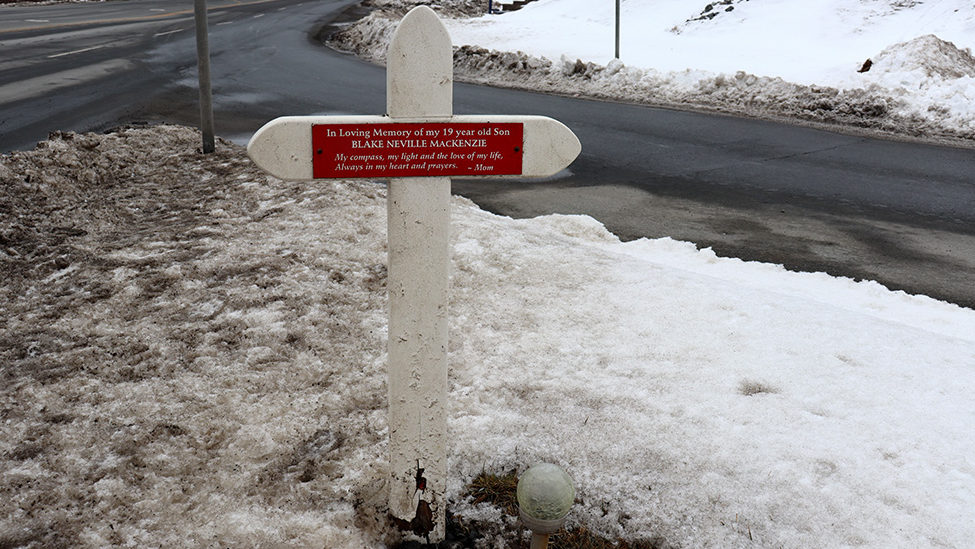
caption
A roadside memorial at the intersection of Duke Street and Damascus Road in Bedford. HRM is currently surveying residents for their thoughts about roadside memorials like this one.Just how long roadside memorials should be permitted to remain is only one question HRM residents are being asked in an online survey closing Feb. 2.
The city is asking residents to voice their thoughts on everything from how big these memorials should be to what the grounds are for justifying a memorial’s removal.
It also goes into whether ghost bikes— a kind of roadside memorial for cyclists— should be placed alongside municipal streets.
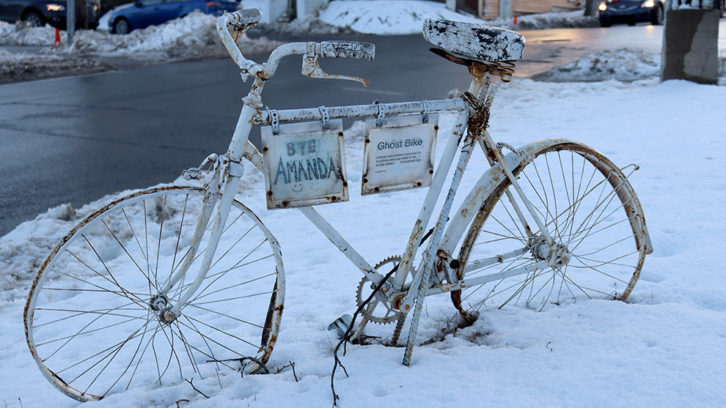
caption
Ghost bikes are roadside memorials for cyclists who have been killed. Their placement on municipal streets is included in HRM’s roadside memorial survey.The survey is another step towards developing policies about roadside memorials in HRM. At the moment, the city has no regulations.
“Right now it is wide open,” Coun. Steve Streatch said in an interview. “As much as you can put something up, somebody else can come and take it down.”
Kathy Best is a Musquodoboit Harbour grandmother who’s all too familiar with this possibility.
In August 2018, HRM took down the memorial for Best’s granddaughter, Kylie Cooper, who died in a car crash at the age of 15. Complaints had been lodged to the city about the memorial, and the family of the elderly man who died in the same crash publicly stated their objections.
But for Best, her daughter Marlene Cooper, and the rest of their family, the city’s removal of their cross was “the worst thing ever.”
“I could not believe that they would put people who have just lost somebody that they love through this kind of agony,” said Best.
With the help of Streatch, Kylie Cooper’s roadside memorial was put back in place.
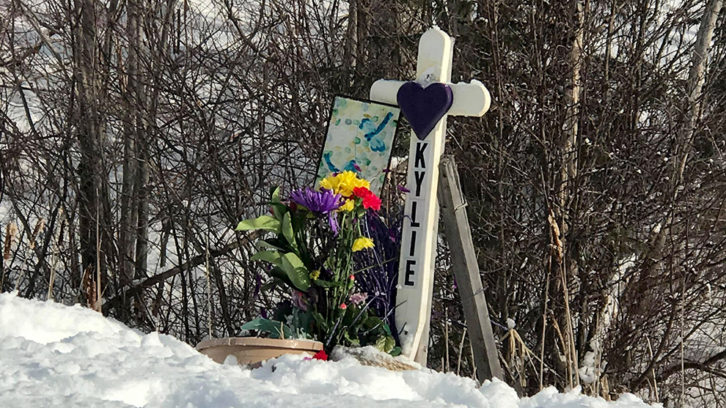
caption
The roadside memorial for Kylie Cooper was returned after HRM city staff removed it.Streatch then motioned for the municipality to develop policies about roadside memorials, and in June 2019 city staff presented a report of proposed guidelines. This report, which included a suggested one-year time limit for memorials, was deemed by Streatch as “a little insensitive.”
Council opted to gather input from the public, which resulted in the municipality’s current online survey.
“We quite simply are wanting to put policies in place that everybody understands from the onset, and go forward,” said Streatch. “So this is more about enabling the placement of memorials than it is about preventing them.”
Best said she’s in favour of policies governing the size, maintenance, and registration of future roadside memorials. However, she takes exception to the idea of imposing a time limit.
The survey asks respondents to choose between six options for how long a memorial should remain in place: 18 months, 24 months, 30 months, up to five years after the incident, up to 10 years after the incident, or other.
“How can they say that a family can only grieve for a year?” Best asked. “It’s going on two years for us, and I don’t know if we’ll ever be the same…There’s nobody who can pick that number for you.”
New Glasgow resident Donna Nugent is similarly disturbed by the notion of a time limit. Her son, Michael Collier, was 23 when he died in a car accident on Sept. 17, 2018. He is remembered by a six foot tall roadside cross on the back of a highway in the area.
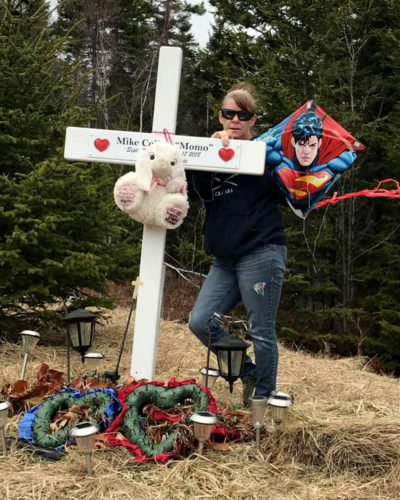
caption
Donna Nugent stands beside the roadside cross for her son Michael.“Now to all of us, that is where Michael’s spot is,” said Nugent.
“We decorate it for every holiday. We have benches there. People go out, they sit.”
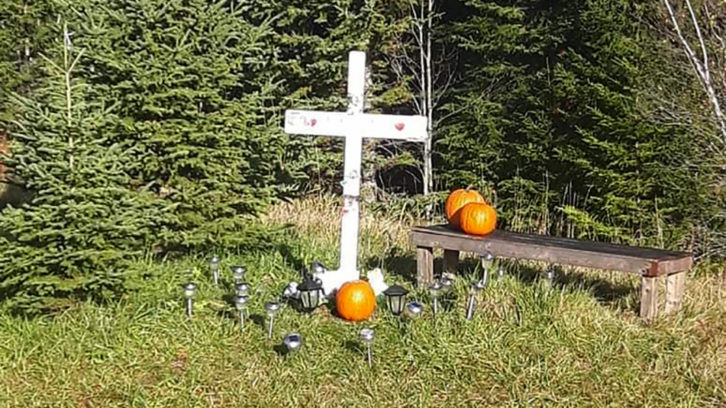
caption
Michael Collier’s roadside memorial, decorated for Hallowe’en.As a resident of Pictou County, Nugent’s cross is located beyond the jurisdiction of HRM. But as far as she’s concerned, “forever” should be an option on the survey.
“To take that cross from me, I would be devastated,” Nugent said.
Marking a threshold
Holly Everett is a folklore professor at Memorial University of Newfoundland. Her 2002 book, Roadside Crosses in Contemporary Memorial Culture, is based on her thesis research about roadside memorials in Austin, Texas. She says many of the memorials she documented in the late ‘90s are still there.
“It’s really, really variable in terms of how long the memorials remain significant to a person,” Everett said. “And the more people involved with that particular memorial, the more variables there are.”
“The way I think about it is how long people need them,” she said.
Everett said another theme that comes up in research about roadside memorials is the need people have to mark the spot of their tragedy.
“It’s very different from somebody passing away in the hospital. A lot of times, you know, the person was just maybe going to work or going to school and then bam, they’re gone,” Everett said. “And that seems to make a big difference for people in terms of having some kind of marker at that particular spot.”
Roadside memorials also serve as warnings to other drivers, said Everett. This was also noted by both Nugent and Best.
“The cross shows the public it’s a dangerous highway,” Nugent said.
“When I see white crosses on the highway, I picture how someone’s car would have went off there. So it just gives you a little more extra caution about that area if there’s a white cross.”
Best is hopeful the survey will help protect her granddaughter’s memorial. But if it doesn’t, she said they’ll continue “until the bitter end.”
“You can be guaranteed that we’ll never stop fighting this,” said Best.
About the author
Andrea McGuire
Andrea McGuire is a journalism student from Newfoundland. Before coming to King's College, she completed a master's degree in folklore at Memorial...

G
Gundi Pieper
J
J
K
Kelly
L
Leeann Galloway